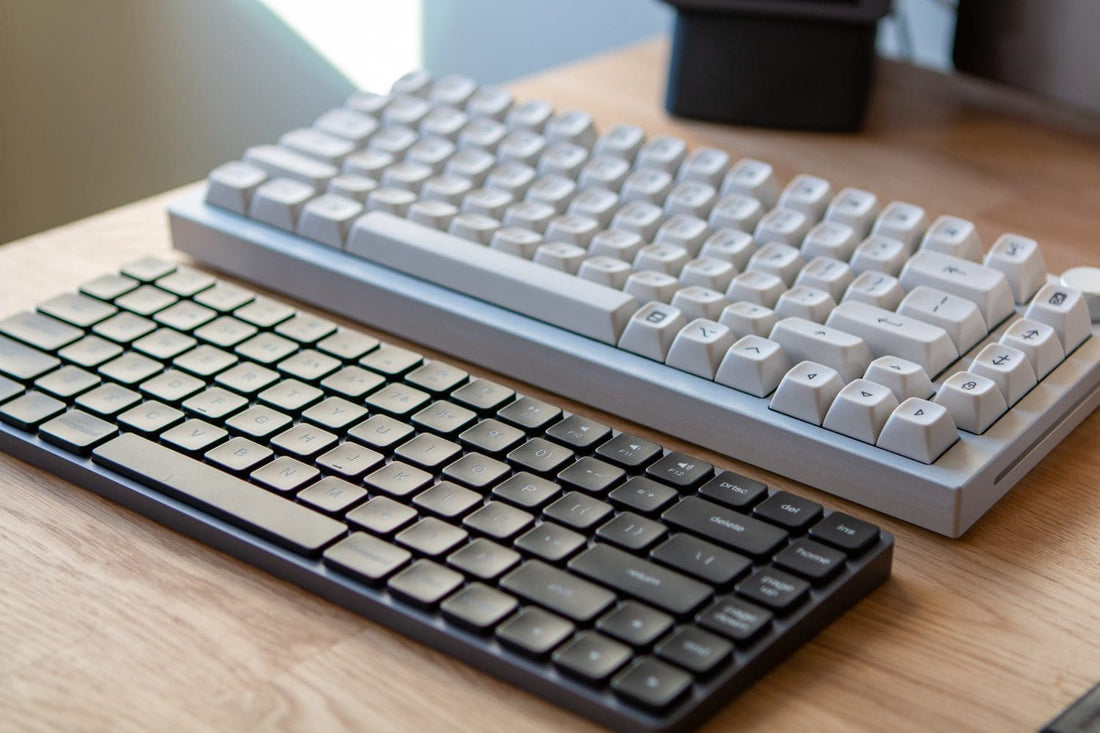Low-profile and normal-profile keyboards have been a hot topic among the keyboard community. If you're scratching your head, wondering what sets them apart, don't worry!
In this blog post, we'll explore the primary difference between low-profile and normal-profile mechanical keyboards, helping you to make the right decision when choosing the best keyboard for your needs.
1. Keycap Height
- Low-Profile: Low-profile keyboards have noticeably shorter keycaps than their normal-profile counterparts. This design can make a more comfortable and ergonomic typing experience, especially for those who prefer a flatter surface.
- Normal-Profile: Traditional mechanical keyboards have taller keycaps, providing a more classic and pronounced look. These keycaps require more force to actuate. The keys are more raised, giving a keyboard traditional and substantial feel.

2. Switch Design
- Low-Profile: The switches used in low-profile keyboards are also shorter in height. The reduced height provides a sleeker and more compact design. This design contributes to a shallower keystroke, making it suitable for users who prefer a faster and more responsive typing experience.
- Normal-Profile: Normal profile keyboards feature longer key switches, resulting in a taller keyboard. This design often results in a deeper key travel, providing more pronounced tactile feedback. This design is more similar to traditional mechanical keyboards. The key switches used in normal-profile keyboards often include the classic Cherry MX switches, providing a familiar and satisfying typing experience.

3. Key Travel and Actuation
- Low-Profile: Keyboards with low-profile switches generally have a shorter key travel distance. It means that you don't need to press the keys as far down to register a keystroke. On low-profile keyboards, the actuation point, where the key register's input, is often lower. It means less effort to press the keys, making it easier on your hands. It can result in a faster response time, making them suitable for quick typists and gamers.
- Normal-Profile: These keyboards typically have a longer key travel distance, giving users a more pronounced tactile feel when typing. This extended travel can be preferred by those who enjoy the sensation of pressing keys more deeply. The actuation point on normal-profile keyboards is often higher than low-profile keyboards, requiring slightly more force to register a key press.
4. Aesthetics and Portability
- Low-Profile: Low-profile keyboards are known for their slim and modern design. Users who value a minimalist and compact desktop environment frequently prefer them. Due to their reduced height and compact form factor, low-profile mechanical keyboards are more portable, making them the best choice for users who need to transport their keyboards with them.

- Normal-Profile: Normal profile mechanical keyboards favored by users who appreciate a classic and substantial look on their desks. The taller keycaps and overall larger size contribute to a more robust appearance. The typing experience on normal-profile keyboards is often considered more traditional and satisfying for users who prefer distinct tactile feedback and audible clicks.

5. Key Sound
- Low-Profile: Low-profile keyboards produce a quieter typing sound than standard-profile keyboards due to their shorter key travel. It can be advantageous in shared or quiet environments where a soft typing noise is preferred.
- Normal-Profile: Traditional mechanical keyboards, with longer keys travel, tend to produce a more audible click with each keypress. It can be satisfying for users who enjoy hearing feedback while typing.
6. Customization Options
- Low-Profile: While customization options may vary, low-profile keyboards often come with RGB lighting and programmable keys to enhance the user experience. The compact design allows for a sleeker integration of lighting effects.
- Normal-Profile: Traditional mechanical keyboards offer various customization options, including RGB lighting and programmable keys. The larger size may provide more space for intricate lighting patterns and additional dedicated keys.
7. Gaming Performance
- Low-Profile: The shorter key travel and faster actuation of low-profile switches can make them well-suited for gaming, especially for genres that require quick and precise key presses. Gamers may find the reduced finger movement beneficial for improved reaction times.
- Normal-Profile: Traditional mechanical keyboards are also popular among gamers, providing a more substantial tactile feel. The longer keys travel can offer a satisfying response for gaming genres where keypress precision is crucial.
8. Switch Variety
- Low-Profile: The variety of switch options for low-profile keyboards may be more limited than the extensive choices available for traditional mechanical keyboards. Users may have fewer options for switching switches based on their preferred actuation force and tactile feedback.
- Normal-Profile: Traditional mechanical keyboards offer several switch options, including linear, tactile, and clicky switches. That allows users to choose a switch that aligns with their typing preferences, making it easier to find the perfect fit.
9. Ergonomics Typing Experience
- Low-Profile: Low-profile keyboards' shorter height and flatter design can contribute to a more ergonomic typing experience, especially for users who prefer a lower keyboard profile. This design aims to reduce wrist strain and provide a more comfortable posture.
- Normal-Profile: Traditional mechanical keyboards, with their taller keycaps, may provide a more natural hand position. The curvature of the keycaps can contribute to a comfortable and ergonomic typing experience, particularly for those accustomed to standard keyboard designs.
10. Durability
- Low-Profile: While the durability of low-profile switches is generally high, the compact design may influence the overall structural integrity of the keyboard. Users should consider the build quality and materials used to ensure long-lasting performance.
- Normal-Profile: Traditional mechanical keyboards are renowned for their durability. The larger size often allows for a sturdier build, making them resilient to heavy usage with time. Mechanical switches are also known for their longevity.
11. Typing Experience
- Low-Profile: The shorter keys travel in low-profile keyboards can appeal to users who prefer a quicker and lighter typing experience. It can be beneficial for tasks that require swift key presses, such as gaming.
- Normal-Profile: Traditional mechanical keyboards offer a more deliberate and substantial typing experience with longer key travel. It can be preferred by those who appreciate a more tactile and pronounced feel while typing.
12. Maintenance and Cleaning
- Low-Profile: Low-profile keyboards are easy to clean and maintain because they have a simple design. There are fewer small spaces for dust and dirt to hide, and the flat surface makes it easy to wipe away any mess. It helps your keyboard last longer.
- Normal-Profile: Traditional mechanical keyboards have more complicated designs with deeper spaces, so cleaning them takes more effort. But don't worry! The switches in these keyboards are durable and can handle it, making up for the extra work you put into keeping them clean.
Conclusion
Choosing between a low-profile and a normal-profile mechanical keyboard depends on personal preferences and usage. If you prioritize a slim and modern design emphasizing portability, a low-profile keyboard may be a good fit for you. On the other hand, if you prefer a classic and tactile typing experience with a more substantial appearance, a normal-profile keyboard could be the better choice.
Elevate your typing experience with Keychron Keyboards, a premier provider of top-notch mechanical keyboards for Mac, Windows, iPhone, and Android. Explore models like Keychron K2, Keychron K3 Pro, and Keychron K8 Pro.

